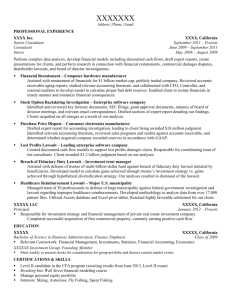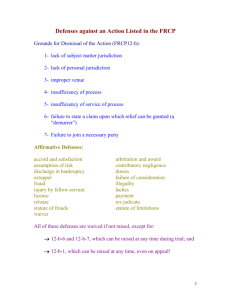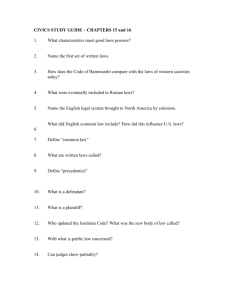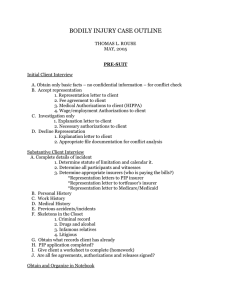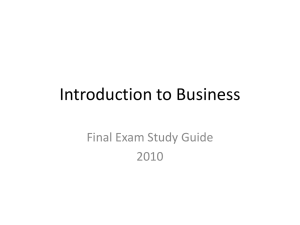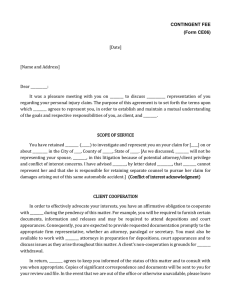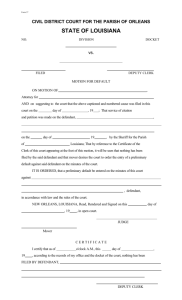PHILIP L. TEW, JD / Ph.D ASSISTANT PROFESSOR OF FINANCE
advertisement
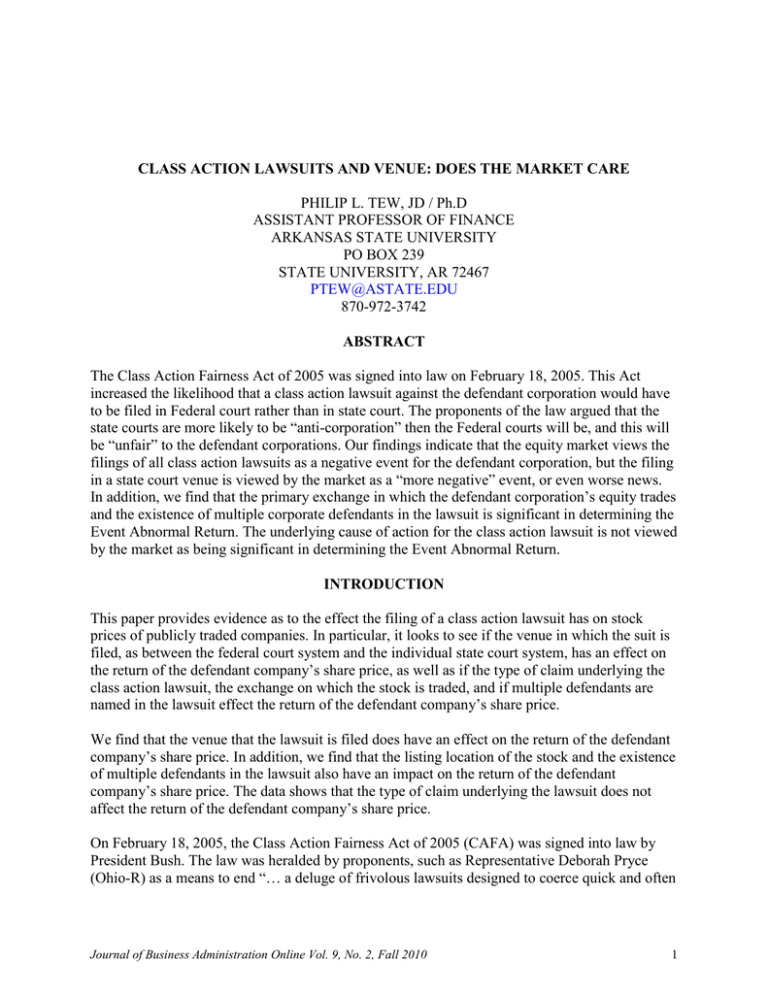
CLASS ACTION LAWSUITS AND VENUE: DOES THE MARKET CARE PHILIP L. TEW, JD / Ph.D ASSISTANT PROFESSOR OF FINANCE ARKANSAS STATE UNIVERSITY PO BOX 239 STATE UNIVERSITY, AR 72467 PTEW@ASTATE.EDU 870-972-3742 ABSTRACT The Class Action Fairness Act of 2005 was signed into law on February 18, 2005. This Act increased the likelihood that a class action lawsuit against the defendant corporation would have to be filed in Federal court rather than in state court. The proponents of the law argued that the state courts are more likely to be “anti-corporation” then the Federal courts will be, and this will be “unfair” to the defendant corporations. Our findings indicate that the equity market views the filings of all class action lawsuits as a negative event for the defendant corporation, but the filing in a state court venue is viewed by the market as a “more negative” event, or even worse news. In addition, we find that the primary exchange in which the defendant corporation’s equity trades and the existence of multiple corporate defendants in the lawsuit is significant in determining the Event Abnormal Return. The underlying cause of action for the class action lawsuit is not viewed by the market as being significant in determining the Event Abnormal Return. INTRODUCTION This paper provides evidence as to the effect the filing of a class action lawsuit has on stock prices of publicly traded companies. In particular, it looks to see if the venue in which the suit is filed, as between the federal court system and the individual state court system, has an effect on the return of the defendant company’s share price, as well as if the type of claim underlying the class action lawsuit, the exchange on which the stock is traded, and if multiple defendants are named in the lawsuit effect the return of the defendant company’s share price. We find that the venue that the lawsuit is filed does have an effect on the return of the defendant company’s share price. In addition, we find that the listing location of the stock and the existence of multiple defendants in the lawsuit also have an impact on the return of the defendant company’s share price. The data shows that the type of claim underlying the lawsuit does not affect the return of the defendant company’s share price. On February 18, 2005, the Class Action Fairness Act of 2005 (CAFA) was signed into law by President Bush. The law was heralded by proponents, such as Representative Deborah Pryce (Ohio-R) as a means to end “… a deluge of frivolous lawsuits designed to coerce quick and often Journal of Business Administration Online Vol. 9, No. 2, Fall 2010 1 unwarranted settlements, often to enrich only a few.” Opponents, such as Nancy Pelosi (California-D), argued that the law was “… a payback to big business at the expense of the consumer.” CAFA sets forth the requirement that any class-action lawsuit seeking at least five million dollars in damages would be removed to federal court unless the state court where the action is filed is home to the primary defendant and more than one-third of the plaintiffs involved in the litigation. The proponents of the law argued prior to the passage of the law, that certain state courts have a greater probability of granting higher verdicts and less likely to remove frivolous lawsuits. The proponents believed that the law would end “forum shopping” by plaintiff attorneys in the filing of the class action suits in those states where higher verdicts were likely. If the proponents of the new law are accurate, then the market would have been expected to act in a more adverse manner toward those class-action lawsuits filed in state courts, rather than federal courts. Section 1: Class Action Research Prior research in the area of the effects on defendant companies’ valuations by the filing of classaction lawsuits, or lawsuits in general, focuses on the specific claim underlying the lawsuit. Hersch (1991) finds that the market value of the equity of a firm falls on average by 15.6% with the filing of a lawsuit based on a claim arising under the Equal Employment Opportunity laws. Hersch also finds that the loss to shareholders exceeds the amount of funds used to settle the lawsuit. Additional research focuses on products liability as the specific claim underlying the lawsuit. Viscusi and Hersch (1990) analyze the effect on the defendant companies’ share prices by the filing of a product liability lawsuit, and how the effects differ over different industries. Garber and Adams (1998) focus their product liability study on the automobile industry and in particular the stock price change upon a verdict announcement. Garber and Adams find that the reactions to the announcement of a verdict of less than thirty million dollars are “essentially random for the predominant number of verdicts.” Garber and Adams interpret their results as “that there is no systematic stock market reaction to increasing award amounts in the range of most awards.” In addition to the previous described prior research, a large amount of research focuses on the violations of federal securities laws (primarily violations of SEC Rule 10b-5 and Section 11 of the Securities Act) as the underlying claim of the lawsuit. This research has looks at litigationbased disclosure incentives (Frances, Philbrick, and Schipper 1994), the type of information presented as well as the pre-lawsuit return and risk of the defendant company (Beck and Bhagat 1997), and the incentives to underprice initial public offerings due to the fear of future shareholder litigation (Hensler 1995). The Beck and Bhagat paper occurred after the passage of the Common Sense Legal Reforms Act, which according to research conducted by Grundfest and Perino (1997), led to a shift in the venue of shareholder litigation from federal court to state court. The current research aids in explaining why Garber and Adams were unable to find any systematic stock market reactions to the announcement of a verdict, in that the stock market reaction could have occurred upon the actual filing of the suit, when the investors learn of the claims being made against the defendant company. As stated by Hersch (1991), “if the Journal of Business Administration Online Vol. 9, No. 2, Fall 2010 2 information is unanticipated, investors would devalue the shares of firms that are sued at the time of the suit” since the information regarding the defense of the claim and the amount, if any, of the settlement is unknown at the time of the filing of the lawsuit. Rather than looking at a specific cause underlying the class-action suit, my research looks at the effect venue has on the return of the defendant company’s share price. The remainder of the paper will be set forth as follows: Section 2 will detail the data used in the research, followed by Section 3 which sets forth the model and tests used to determine the effects; Section 4 states the results of the models and tests, and Section 5 concludes. Section 2: Data Description The sample for this study consists of class action lawsuits filed against publicly traded companies in 1999. A search was performed on Lexis-Nexis to find information / article releases on class action lawsuits that had been filed in the year 1999. This search netted seven hundred and fifty-six (756) articles; however there were multiple information / article releases on the same class action lawsuits. Additionally, there was multiple class action lawsuits in different jurisdictions and venues filed against the same corporate defendant(s) for the same underlying violation of the same law. The removal of the multiple information / article releases and multiple class actions for the same action resulted in a total of one hundred and seven (107) lawsuits. Of these remaining lawsuits, fifty-two (52) were for companies traded on NYSE, NASDAQ, or AMEX, and had data available on the Center for Research of Security Prices (“CRSP”) for the period of sixty (60) days prior to the filing of the class action lawsuit to the day after the filing of the lawsuit. Section 3: Model and Tests Implemented The event study methodology set forth by MacKinlay (1997) is utilized in the research. As MacKinlay states, “theoretical insights can result from examining the association between the magnitude of the abnormal return and characteristics specific to the event observation.” We calculate the dependent value, Event Abnormal Returns (EAR) for the defendant company’s share price, as follows. The stock returns for the individual defendant company is calculated from the closing market data for the period consisting of sixty days prior to the date of the filing of the lawsuit. The returns are then calculated in excess of the returns for the same time period for the value-weighted average of the market consisting of all stocks trading on NYSE, NASDAQ, and AMEX, since all defendant firms in the sample trade on one of these three sites. An average of the excess returns for the sixty days prior to each lawsuit is then calculated. Next, an average of the excess returns for the day the lawsuit is filed and the next trading day is calculated. The multiple post event days is utilized to allow for the dissemination of the information to the market participants through media sources. The pre-event average of excess returns is then subtracted from the event / post-event average of excess returns to yield the event abnormal return (EAR), EAR = [ (1/60) Σ ( Ra(t-f) –Re(t-f)) ] –[(1/2) Σ (Ra(t+d) –Re(t+d)) as f→[1,60] and d→[0,1] Journal of Business Administration Online Vol. 9, No. 2, Fall 2010 3 where Ra(t-f) is the actual pre-lawsuit filing return of the stock for day t-e, Re(t-f) is the expected pre-lawsuit filing return for the stock for day t-e, Ra(t+d) is the actual post-lawsuit filing return of the stock for day t+d, and Re(t+d) is the expected pre-lawsuit filing return for the stock for day t+d. A total of five (5) independent variables were utilized in the regression, and they are defined as follows: NYSE –This variable will take the value of one if the defendant corporation’s common stock is traded on the New York Stock Exchange. The variable will take a value of zero if the stock trades on NASDAQ or a non-NYSE exchange. SC –This variable will take the value of one if the class action lawsuit is filed in a state court, and will take the value of zero if the class action is filed in a federal court. Based on the arguments set forth by the proponents of the Class Action Fairness Act of 2005 that state courts give tend to give higher verdicts and are less likely to dismiss frivolous claims, then the increased uncertainty coupled with the probability of a larger verdict, should cause the parameter estimate for this variable to be negative and statistically significant. SV –This variable will take the value of one if the underlying claim for which the lawsuit was filed is a violation of either federal or state securities laws. This variable, along with CFR, was added to the model to determine if a specific type of class action lawsuit has a significant effect, or an effect larger than the venue in which the case was filed, on the EAR of the defendant company. CFR –This variable will take the value of one if the underlying claim for which the lawsuit was filed was based on consumer fraud. The majority of the class action lawsuits filed during the sample period fall into either this category or SV, with the remaining lawsuits being too few to warrant an additional variable. MD –This variable will take the value of one if the class action lawsuit names multiple companies as defendants (it should be noted that lawsuits where one company and members of the board of directors or officers are named as defendants are treated as though it is a single defendant), and will take the value of zero if the lawsuit only has one corporate defendant. It is expected that the naming of multiple defendants in a single class action lawsuit will have a negative and statistically significant effect on the EAR for the defendant company. Thus the model takes the following form: EAR = β0 + β1(NYSE) + β2(SC) + β3(SV) + β4(CFR) + β5(MD) + ε Upon using ordinary least squares to calculate the above model, T-tests are used to determine statistical significance of the individual variables, and an F-test is utilized to determine if the type of lawsuit has an effect on the EAR upon the filing of the suit. Journal of Business Administration Online Vol. 9, No. 2, Fall 2010 4 Section 4: Model Results Table 1 shows the parameter estimates and the t-value for each of the estimates of the equation: EAR = β0 + β1(NYSE) + β2(SC) + β3(SV) + β4(CFR) + β5(MD) + ε where NYSE is a dummy variable equal to 1 if the defendant corporation trades on the New York Stock Exchange and 0 otherwise. SC is a dummy variable equal to 1 if the lawsuit is filed in state court and 0 otherwise. SV is a dummy variable equal to 1 if the underlying cause of action for the lawsuit is a securities violation and 0 otherwise. CFR is a dummy variable equal to 1 if the underlying cause of action for the lawsuit is a consumer fraud complaint and 0 otherwise. MD is a dummy variable equal to 1 if there are multiple defendants in the lawsuit and 0 otherwise. All estimates had the predicted sign with the exception of MD, and three of the five variables (NYSE, SC, and MD) were statistically significant at least at the 10% level. Table 1 Estimates for Variables for the Equation Variable Intercept NYSE SC SV CFR MD Parameter Estimate (T-Value) 0.95586 1.04 -1.14538* -2.02 -1.4784** -2.32 -0.10604 -0.13 -1.13085 -1.55 1.87903*** 2.87 The results show that the market reacts by following the arguments set forth by the proponents of the CAFA of 2005, in that holding all other variables constant, the filing of a class action lawsuit in state court rather than in federal court will result in a negative abnormal return of 1.47840 to the defendant corporation’ common stock. This parameter estimate is statistically significant at the five percent (5%) level. The sign, amount, and significance is likely related to the larger range of values of verdicts that are likely in state court versus the smaller range in federal court lawsuits. Contrary to what was expected, the sign of the parameter estimate for MD was positive. In addition to being positive, the parameter estimate itself is large (1.87903) and is also statistically significant at the one percent (1%) level. This result runs contrary to our initial thought that the naming of multiple defendants in a single class action lawsuit would be viewed by the market as a negative occurrence, since that would be a signal to investors that the industry itself is being Journal of Business Administration Online Vol. 9, No. 2, Fall 2010 5 effected by the lawsuit (in the sample of lawsuits, all multiple defendants lawsuits involve defendants in the same industry). This result could be that the market views the filing of a lawsuit against multiple defendants within the same industry as a positive sign in that all of the competitors are being placed at the same “disadvantage” and no one competitor will be able to take advantage of their competitors. The data also showed that if the stock was listed on the NYSE when the class action lawsuit was filed, then the effect was statistically significant and negative. The larger sizes of the firms in terms of market value in the sample for the NYSE firms in relation to the remaining firms from the sample as well as the larger trading volume could be the reasoning behind the results. The larger firms, in terms of market value, can be viewed as a larger “target” by plaintiffs’ attorneys, who will in turn seek greater settlements or verdicts from these firms. Neither the variables SV or CFR were statistically significant at the ten percent (10%) or less level. An F-test was then calculated for the following hypothesis Ho = β3 = β4 = 0 to determine if the type of class action lawsuit has an effect on the EAR upon the filing of the class action lawsuit. In this case, Ho is unable to be rejected at the 10% level, so the type of lawsuit could affect the EAR. The overall fit of this model is in line with previously discussed research’ overall fit estimates. The present model calculated an R-square of .2393 and an adjusted R-square of .1442. Section 5: Conclusion This research shows that the marketplace has the same belief in actions filed in state courts that the proponents of the CAFA of 2005 have, in that the filings of class action lawsuits in state courts are met with greater effects on the return of the defendant company’ share price. This view of state court litigation would have to be due to either a pervasive, but wrong, belief in the amount of state court judgments or “fairness” of the state courts, or the more likely case of historically higher state court judgments and the greater “anti-corporate” defendant mentality in state courts. References Associated Press Wire Service. (2003). “House Passes Class Action Lawsuit Changes.” June 12. Associated Press Wire Service. (2005). “Congress OKs Law on Class Action Suits.” February 17. Beck, James, and Sanjai Bhaget. (1997). “Shareholder Litigation: Share Price Movements, News Releases, and Settlement Amounts.” Managerial and Decision Economics 18 (7/8) (November – December, 1997): 563-586. Journal of Business Administration Online Vol. 9, No. 2, Fall 2010 6 Frances, Jennifer, Philbrick, Donna, and Katherine Schipper. (1994). “Shareholder Litigation and Corporate Disclosures.” Journal of Accounting Research 32 (2, Autumn): 137-164. Garber, Steven, and John Adams. (1998). “Product and Stock Market Responses to Automotive Product Liability Cases.” Brookings Papers on Economic Activity, Microeconomics. 1-53. Grundfest, J.A., and M. A. Perino. (1997). “Securities Litigation Reform: the First Year’ Experience.” Working Paper. Hensler, Douglas. 1995). “Litigation Costs and the Underpricing of Initial Public Offerings.” Managerial and Decision Economics 16 (2, March –April): 111-128. Hersch, Joni. (1991). “Equal Employment Opportunity Law and Firm Profitability.” Journal of Human Resources 26 (1, Winter): 139-153. MacKinlay, A. Craig. (1997). “Event Studies in Economics and Finance.” Journal of Economic Literature 35 (1, March): 13-39. Viscusi, Kip, and Joni Hersch. (1990). “The Market Response to Product Safety Litigation.” Journal of Regulatory Economics 2 (September): 215-230. Journal of Business Administration Online Vol. 9, No. 2, Fall 2010 7

